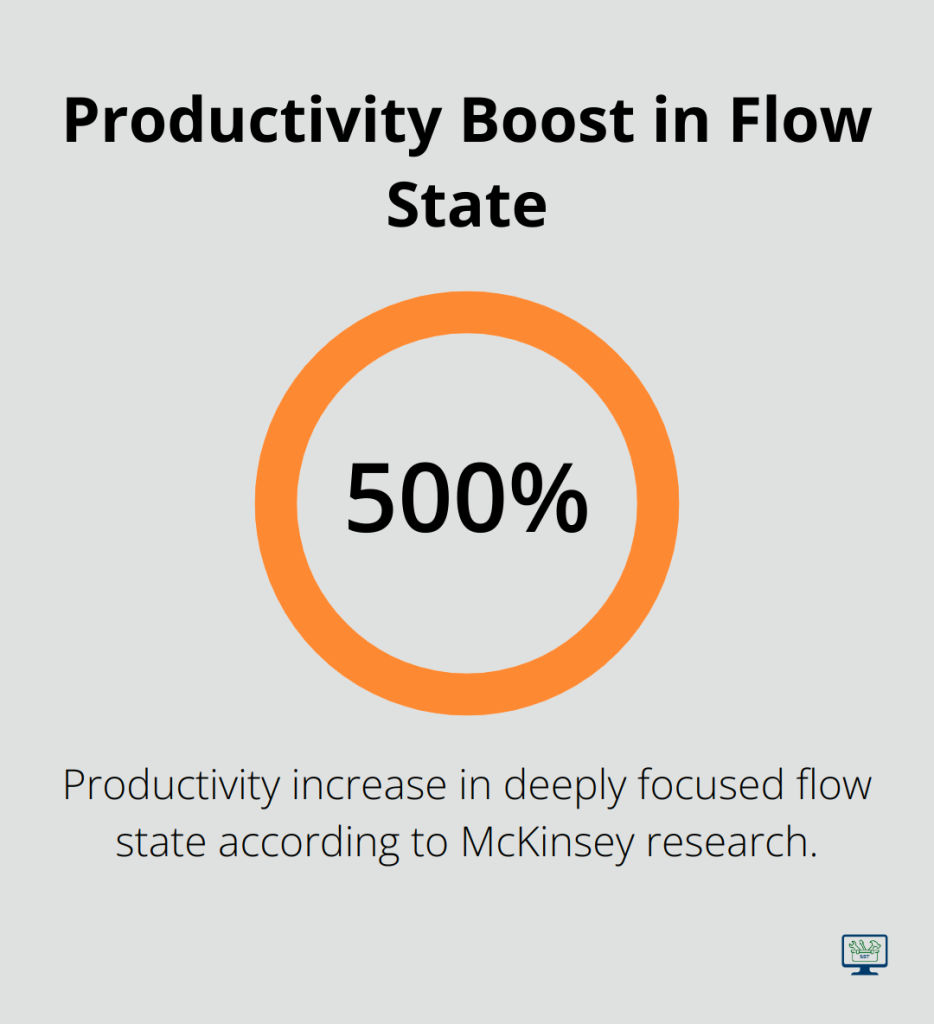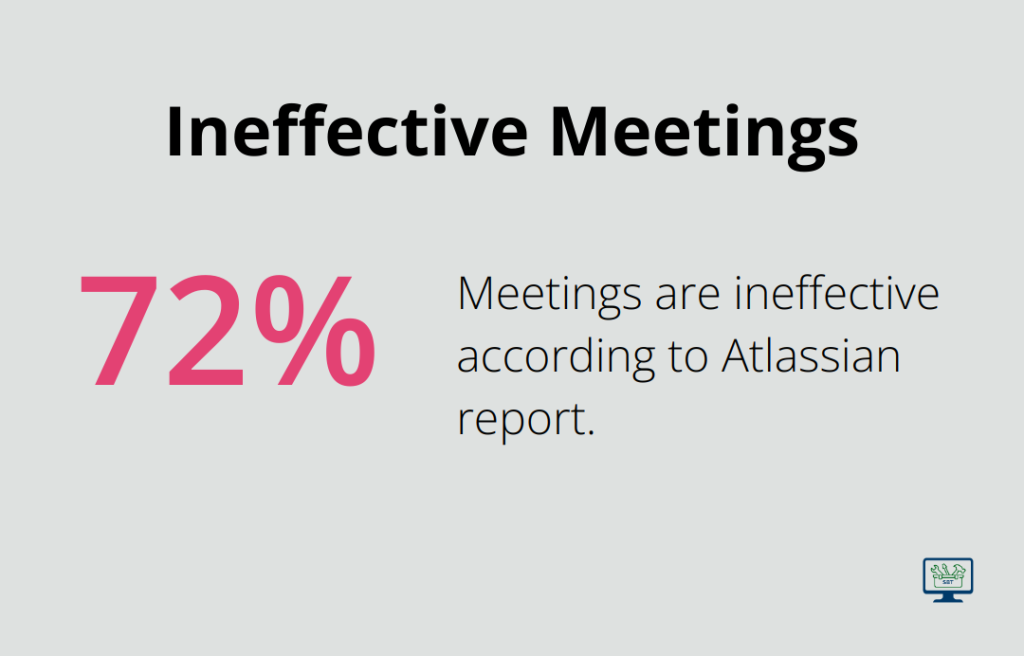At SmallBizToolbox, we know that running a business often feels like juggling a million tasks at once. But not all tasks are created equal.
Task prioritization is the key to unlocking your business’s full potential. By focusing on what truly matters, you can boost productivity, reduce stress, and achieve your goals faster.
What Is Task Prioritization?
The Art of Ranking Tasks
Task prioritization is the process of ranking your to-do list based on importance and urgency. It requires you to decide which tasks need your immediate attention and which can wait. For small business owners, this skill isn’t just helpful-it’s essential for survival and growth.
The Measurable Impact of Prioritization
McKinsey research found that we’re 500% more productive in the deeply focused flow state. This stark difference highlights how proper task management can significantly influence business success.

At its core, prioritization focuses on allocating your limited time and resources to activities that will have the biggest impact on your business goals. This might mean dedicating more hours to client acquisition rather than reorganizing your filing system.
Debunking Common Myths
Many business owners believe they excel at prioritizing, but their actions often tell a different story. Atlassian reports that meetings are ineffective 72% of the time, suggesting that many aren’t effectively prioritizing their time.

Another widespread misconception equates busyness with productivity. In reality, tackling low-value tasks might make you feel accomplished, but it doesn’t necessarily move your business forward. True prioritization often requires you to say no to less important tasks, even if they’re easier or more comfortable to do.
The Hidden Costs of Poor Prioritization
Poor prioritization can result in missed deadlines, stressed employees, and dissatisfied customers. A report by the Project Management Institute found that organizations with high-performing project management capabilities meet original goals and business intent two-and-a-half times more often (89 percent versus 34 percent) and waste 13 times less money than their low-performing counterparts.
For small businesses, where resources are typically limited, this waste can be particularly damaging. It’s not just about losing money-it’s about missing opportunities for growth and innovation.
The Path to Effective Prioritization
To prioritize effectively, you need to develop a clear understanding of your business goals and the tasks that directly contribute to achieving them. This involves regular assessment of your to-do list and the courage to delegate or eliminate tasks that don’t align with your primary objectives.
Tools like the Eisenhower Matrix (which we’ll explore in the next section) can help you categorize tasks based on their urgency and importance. By implementing such strategies, you’ll be better equipped to focus on what truly matters for your business success.
How to Prioritize Tasks Effectively
The Eisenhower Matrix: Urgent vs. Important
The Eisenhower Matrix is a productivity, prioritization, and time-management framework designed to help you prioritize a list of tasks or agenda items. It divides tasks into four categories based on urgency and importance:
- Urgent and Important: Complete these tasks immediately.
- Important but Not Urgent: Schedule these tasks.
- Urgent but Not Important: Delegate these tasks if possible.
- Neither Urgent nor Important: Eliminate these tasks.
For example, responding to a client’s urgent query falls into the first category, while long-term business planning fits into the second. The goal is to focus most of your time on important tasks, regardless of their urgency.
ABC Analysis: High, Medium, Low Priority
ABC Analysis categorizes tasks into three groups:
A – High priority tasks with significant consequences if not completed.B – Medium priority tasks that are important but not critical.C – Low priority tasks with minimal consequences if left undone.
Focusing on ‘A’ tasks ensures that your most critical work gets done first.
Time Management Techniques: Pomodoro and Time Blocking
The Pomodoro Technique involves working in focused 25-minute intervals followed by short breaks. This method helps maintain concentration and prevent burnout.
Time blocking schedules specific time slots for different tasks or types of work. For instance, you might block out 9-11 AM every day for your most important tasks when your energy levels are highest.
Time blocking has been proven to boost productivity up to 80%. This approach creates a structured workday and reduces multitasking, which can decrease productivity by up to 40% (according to University of Michigan research).

Implementing Prioritization in Your Business
To implement these methods:
- List all your tasks for the week.
- Use the Eisenhower Matrix to categorize them.
- Apply ABC Analysis to further refine your priorities.
- Use time blocking to schedule your high-priority tasks during your most productive hours.
Prioritization improves with practice. As you consistently apply these methods, you’ll become more efficient and focused on the tasks that truly drive your business forward.
The next chapter will explore the tangible benefits of proper task prioritization, including increased productivity, improved time management, and reduced stress levels. These advantages demonstrate why mastering prioritization is essential for business success in today’s fast-paced environment.
The Real Impact of Task Prioritization
Productivity Boost
Task prioritization transforms businesses. Meaningful work plays an important role in enhancing employee engagement and providing employees with skill and task variety is important to achieving productivity gains. This productivity surge can mean the difference between meeting deadlines and constant catch-up.
A small marketing agency implemented the Eisenhower Matrix and reported a 40% increase in completed projects within three months (without increasing work hours). They delivered more value to clients in less time by focusing on high-impact tasks.
Stress Reduction and Team Morale
Prioritization affects output and wellbeing. Paycom reports that 63% of workers are ready to quit to avoid work-related stress. However, businesses that prioritize tasks effectively see significant stress reduction.
A small tech startup saw employee satisfaction scores increase by 35% after implementing a company-wide prioritization system. Team members felt more in control of their workload and less overwhelmed by competing demands.
Data-Driven Decision Making
Clear priorities simplify decision-making. You align actions with important business goals instead of relying on gut feelings.
A retail business owner focused on data analysis as a high-priority task. This dedication uncovered insights leading to a 20% sales increase within six months. She made informed decisions about inventory, pricing, and marketing that directly impacted her bottom line.
Time Management Mastery
Effective prioritization leads to better time management. The Pomodoro Technique (25-minute focused work intervals followed by short breaks) helps maintain concentration and prevent burnout.
Time blocking schedules specific slots for different tasks. This approach creates a structured workday and reduces multitasking, which can decrease productivity by up to 40% (according to University of Michigan research).
Enhanced Team Collaboration
Prioritization improves team collaboration. When everyone understands task importance, teams work more efficiently. A software development company reported a 30% reduction in project delays after implementing a shared prioritization system.
Clear priorities also reduce conflicts over resource allocation and deadline management. Teams focus on what matters most, leading to smoother workflows and better outcomes.
Final Thoughts
Task prioritization transforms business operations and achieves remarkable results. The Eisenhower Matrix, ABC Analysis, and time management techniques focus efforts on high-impact activities that drive growth and success. Increased productivity, improved decision-making, and reduced stress levels demonstrate the power of effective prioritization in every aspect of business.
Consistent practice improves task prioritization skills over time. Regular assessment and prioritization of tasks (for you and your team) lead to significant improvements in business efficiency and effectiveness. Prioritization helps you navigate small business challenges and seize growth opportunities by focusing on the most important activities.
We at SmallBizToolbox offer tools and resources to implement effective task prioritization strategies. Our platform provides AI-driven content creation, SEO optimization, and personalized toolkits to streamline your operations. Take action today to improve your task prioritization and watch your business thrive.
How useful was this Resource?
Click on a star to rate it!
Average rating 0 / 5. Vote count: 0
No votes so far! Be the first to rate this post.
We are sorry that this post was not useful for you!
Let us improve this Resource!
Tell us how we can improve this Resource?




